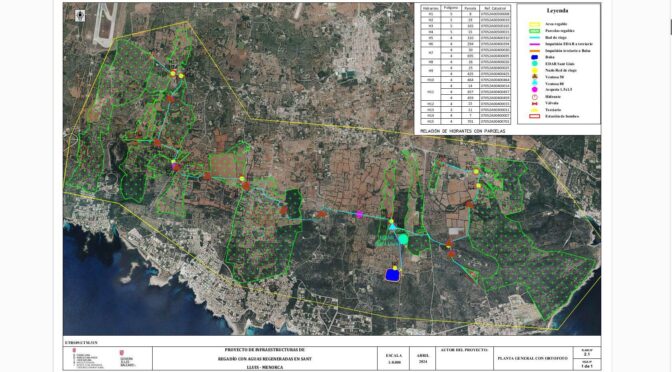Views: 207
Irrigation with contaminated water
The Balearic Government’s Department of Agriculture says it intends to significantly increase the irrigated areas of Menorca, but it has not clarified where the necessary water will come from.
One of the most imminent projects — the use of treated wastewater for irrigation in Sant Lluís — raises fears of contamination due to the poor quality of the water. This initiative directly contradicts existing water management policies.
The project is to be financed with public funds, amounting to around 8 million euros. GOB submitted detailed objections outlining all the concerns the project raises. No response has been received, but the Government has announced that it plans to start construction soon.
Below is a summary of the information explaining GOB’s concerns:
- The official documentation acknowledges that water extractions from the wells in the area intended for irrigation are unknown. Many wells are not registered, and there are no data on their use or concessions.
- In 34 of the 51 wells described (i.e. two-thirds), even the depth of the extraction pumps is unknown.
- There is no guarantee that the project will reduce current groundwater extractions.
- No cost recovery mechanism is foreseen, despite this being a European Union requirement since 2000.
- According to 2023 data from Abaqua, the Sant Lluís wastewater treatment plant shows chloride levels of 475.33 mg/l.
- The average chloride concentration recorded in the Hydrological Plan of the Balearic Islands for the Maó groundwater body (1901M1) is 209 mg/l. Therefore, the treated water shows more than double the chloride concentration of the aquifer.
- The Balearic Water Council has approved the “Important Issues Scheme”, which states that treated wastewater cannot be reused when chloride concentrations exceed 250 mg/l.
- The latest report from the Balearic Water and Environmental Quality Agency indicates that 61.6 % of the wastewater arriving at the Sant Lluís plant fails to comply with the regulations required for proper treatment.
- Sant Lluís has an industrial estate, which entails a constant risk of receiving industrial components that treatment plants cannot eliminate, potentially very polluting and persistent substances.
- This project is not included in the current Hydrological Plan. It is being improvised by the Department of Agriculture.
- Near the proposed irrigation area there are at least seven public supply wells: Binisafúller 1, Binisafúller 2, Ctra Nord B. Vell, Ctra Sud B. Vell, Creuer Pta Prima Nord, Creuer Pta Prima Sud, and Ctra Alcalfar Nord.
- The project includes no safeguards against potential pesticide-related contamination.
- The entire area where treated water is to be used is classified as a Risk Protection Area for groundwater contamination.
Menorca already has problematic cases of irrigation ponds where the water quality is too poor for use, such as in Ciutadella and Es Mercadal, where chloride levels are harmful both to crops and to aquifers.
GOB calls on public institutions to reconsider this project and act wisely. Public investment should aim to improve the state of groundwater resources, not endanger them.

